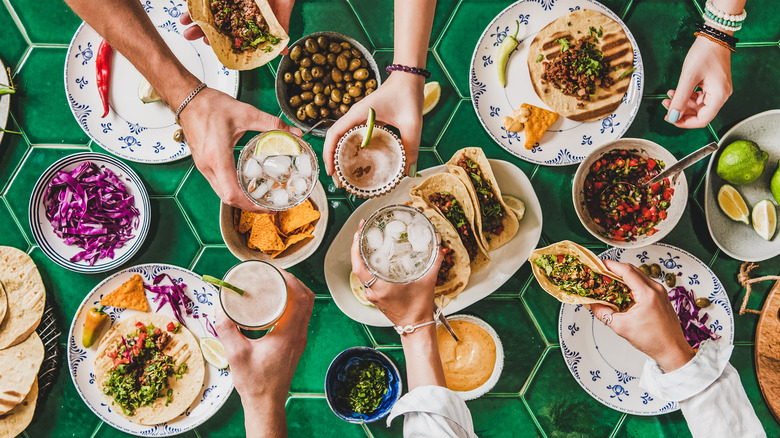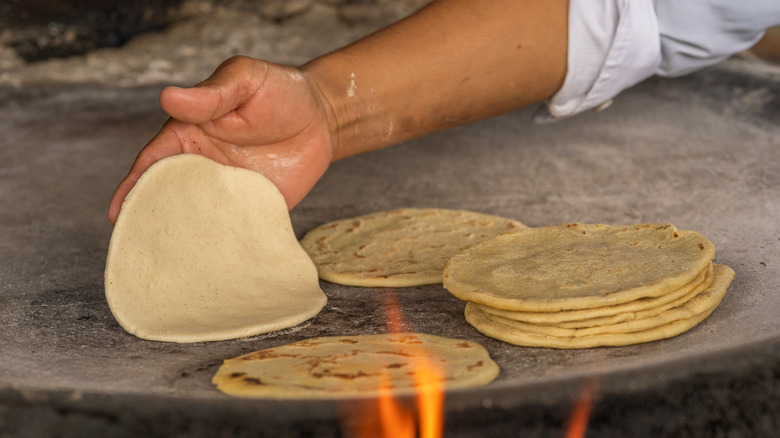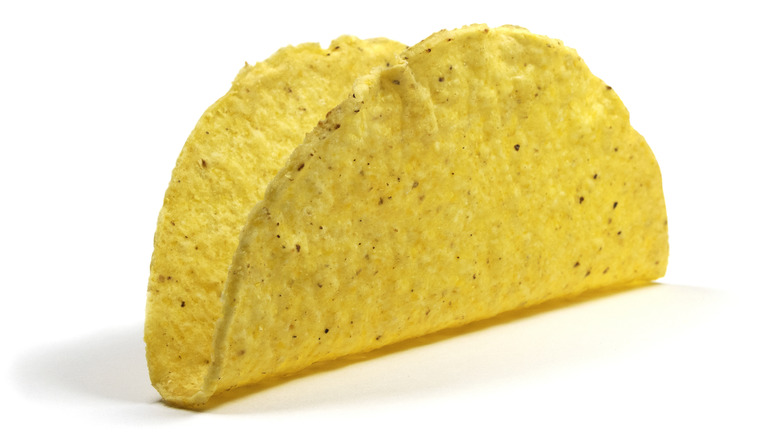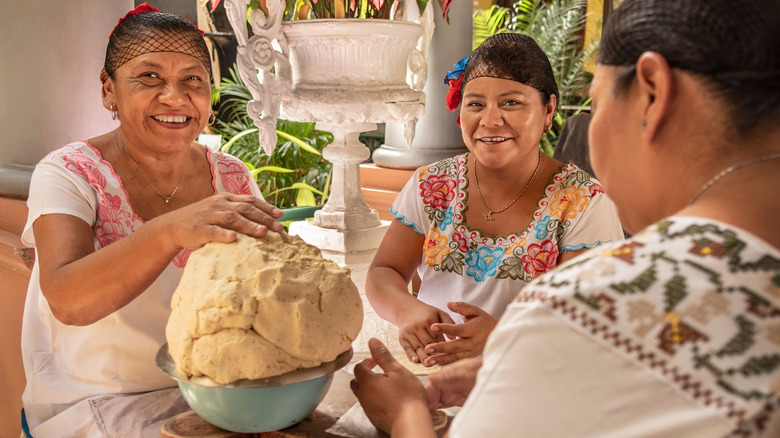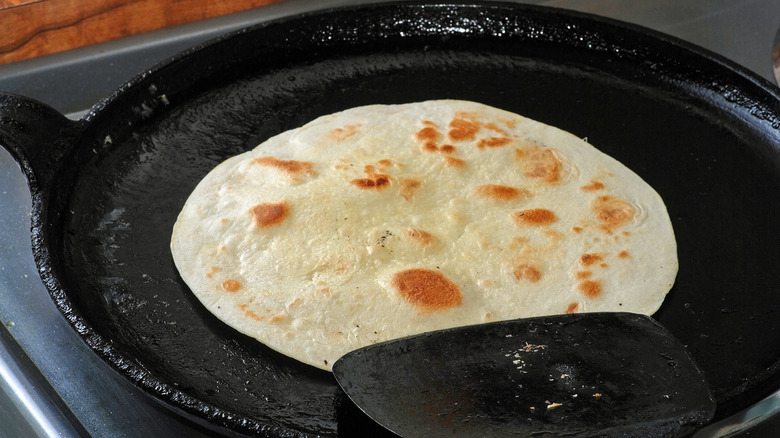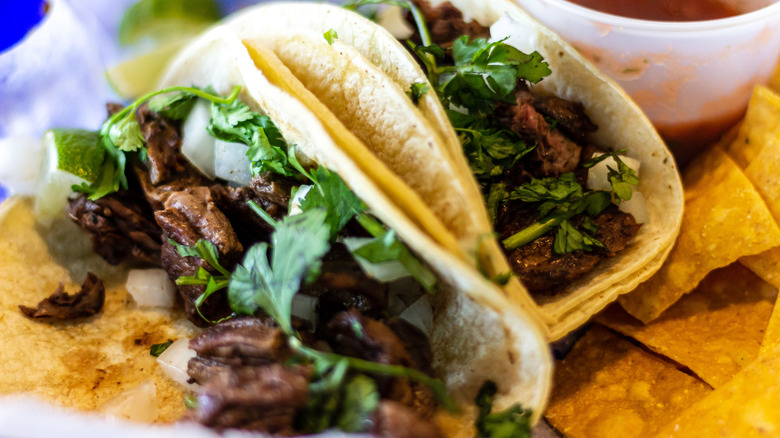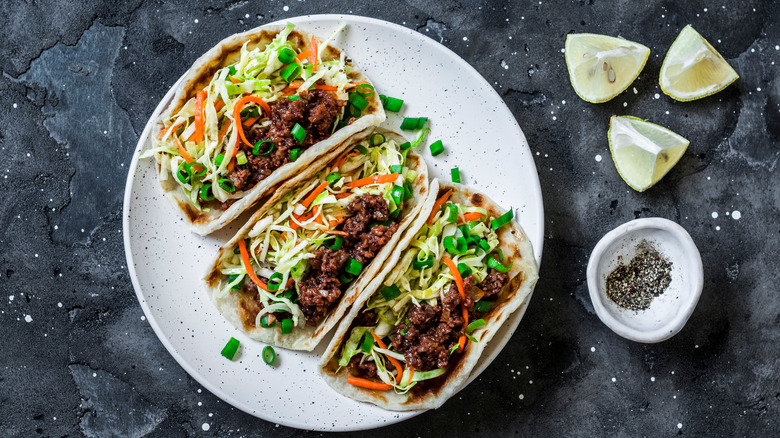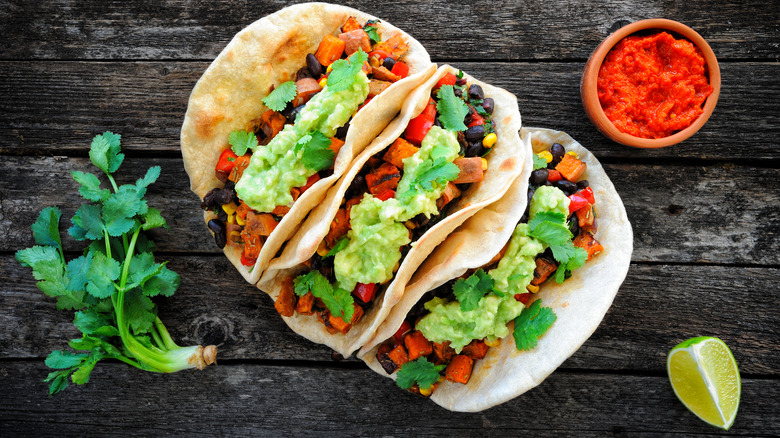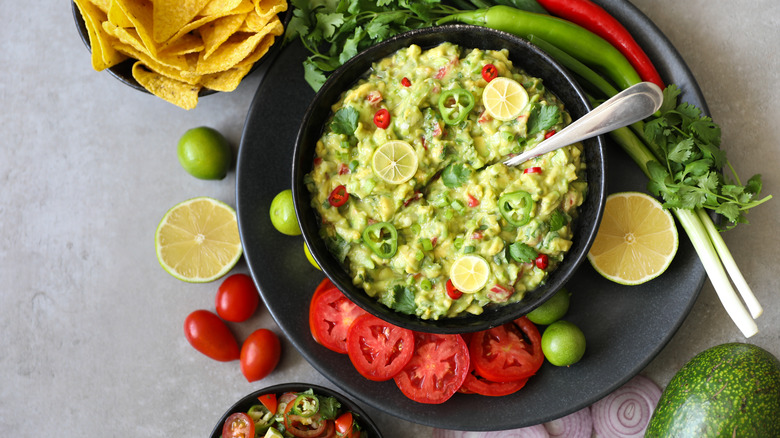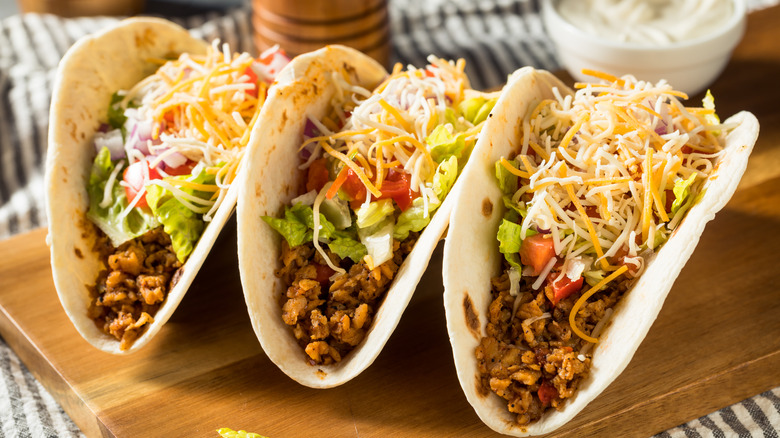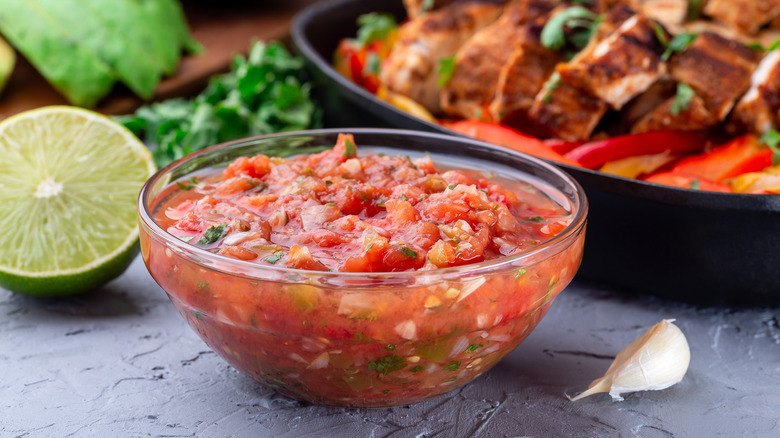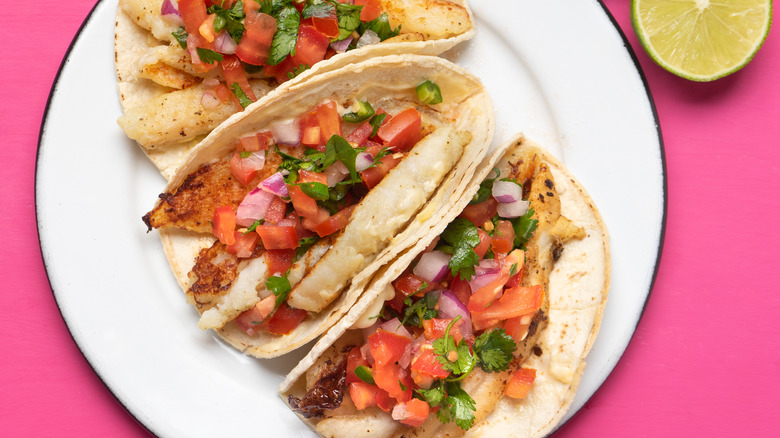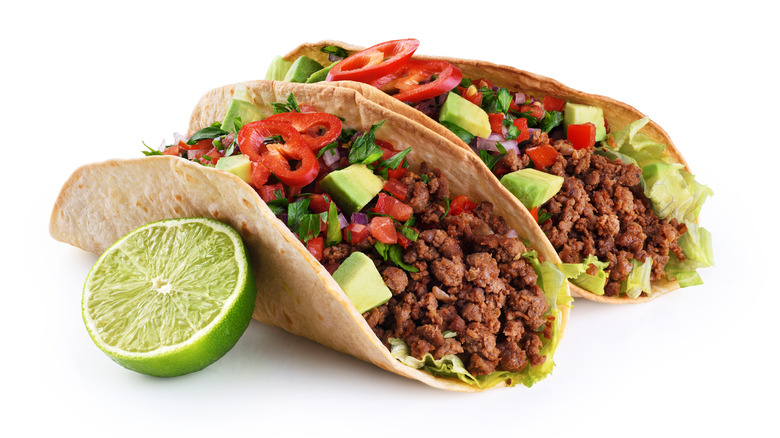Huge Mistakes Everyone Makes When Making Tacos
The direct translation of taco means to plug, however, in Mexican Spanish it entails a light lunch — or a meal that fills a pit in your stomach (via South Florida Reporter). Served across the globe, tacos are a popular go-to snack and meal option. In fact, more than 4.5 billion tacos are sold in the U.S. each year alone, which amounts to 490 miles if you were to place them all side by side (via Chef Lola's Kitchen). The tasty wraps can also be found on most American street corners and at a multitude of restaurants — 55,755 to be precise (via IBIS World). There's even a National U.S. Taco Day scheduled on the 4th of October.
By definition, a taco can be anything eaten inside a soft flour or corn tortilla. The possibilities are endless and fillings range from traditional minimalist ingredients to off-the-wall concoctions. And while taco recipes are as varied as their creators, not all tacos are created equal. In fact, some are much tastier than others. According to many experts, modern Tex-Mex taco recipes have over-complicated the bundles of deliciousness, shifting too far from classic Mexican preparations. From ingredients to structure, here are some of the most common mistakes many of us make when whipping up tacos.
Making tortillas out of flour and not corn
Although nowadays flour is a common ingredient in tortillas, traditionally the flatbread was made from corn. Already a part of the Mesoamerican diet centuries ago, corn as we know it became fundamental to agriculture through cross-pollination. Sometime later, the ingredient started being used to make tortillas thanks to nixtamalization, a process whereby corn kernels are soaked in a mix of water and quicklime before being made into soft dough or masa (via The New Gastronome).
Since nixtamalization is rather time-consuming, most corn tortillas today are made from a mix of masa harina and water. While masa harina looks like ground cornmeal, in fact, it's ground corn kernels soaked in limewater. And when it comes to corn tortillas, they aren't just more authentic than their flour counterparts, they are also more nutritious due to the process they undergo. According to Healthline, corn tortillas are lower in fat, calories, and carbs than flour tortillas. They are also a good source of magnesium and fiber, as well as being gluten-free.
Using pre-fried hard taco shells
The image of crispy taco shells filled with ground beef topped with lettuce, tomato, and shredded cheese was popularized by American fast-food chains in an attempt to streamline their operations. And while hard-shell tacos may be the go-to comfort food of many American families, they have very little in common with classic Mexican soft tortilla tacos (via Twisted Taco). According to Robb Walsh, the author of "Tex-Mex Cookbook: A History in Recipes and Photos," Glen Bell first invented the pre-formed taco shells at his restaurant Taco Tia in the 1950s.
Hard-shell tacos aren't a very practical option when it comes to easy consumption since they are prone to cracking and breaking apart, which means less filling in your mouth and more in your lap. If hard-shell tacos are your jam, Mental Floss points to an easy way to keep their structure intact. Referring to advice from a Reddit user, start by placing some cheese in the bottom of the shell to seal the tortilla before adding the ground beef and other ingredients on top.
Not using fresh or high-quality tortillas
When it comes to tortillas, freshness matters. And no, a delicious filling won't make up for a sub-par tortilla. As such, there's no substitute for homemade taco wraps. Hence, many chefs choose to make their own soft tortillas with a comal or a Mexican flat griddle. According to Nick Evens from Macheesmo, the process is easier than it appears. "The more I make them, the faster I get, and they are so cheap and so delicious," he says.
While homemade tortillas are unbeatable, sometimes there's just not enough time in the day to make them from scratch. And, let's face it, at times store-bought tortillas can do the job just fine. If you decide to buy them ready-made, chef Richard Sandoval of Richard Sandoval Hospitality recommends opting for refrigerated or frozen tortillas over their shelf-stable counterparts. "They simply taste better and have better texture," he tells Insider.
Not heating tortillas the correct way
Perhaps the greatest mistake when making tacos is not warming up the tortillas. After all, warm tortillas aren't just tastier but also more flexible and easier to fold around the filling. Ideally, tortillas should be heated on a flat-top griddle or a cast-iron or stainless steel pan. Chef Danny Mena tells Epicurious that he usually places the tortillas between two pieces of parchment paper before cooking them on a skillet or a griddle until they are speckled with golden spots.
Though it might seem arbitrary, there are wrong ways to heat up and store tortillas. Wraps heated in the microwave tend to get moist and soggy, making for unappealing tacos. Once you've properly warmed up your tortillas, wrap them in a damp towel in a bowl, and cover them with a plate until the tacos are ready to assemble. This will stop them from drying out and cracking when you add the filling (via The Spruce Eats).
Not double stacking the tortillas
According to Lesley Téllez, author of "Eat Mexico: Recipes From Mexico City's Streets, Markets and Fondas," a lot of authentic Mexico City taco trucks or taquerias serve tacos in two tortillas. "They'll ask if clients want one or two, in case they're watching their waistlines. Particularly with a liquidy filling like a guisado, the first tortilla breaks, so the second one serves as a backup. How you eat your taco is up to you — como quieras," she tells Westworld.
Aside from providing added security in case the first tortilla splits, what's the reason for the extra one? Many people speculate that they serve a purely practical purpose of catching any ingredients in case the taco is overfilled. According to one Chowhound user, the second tortilla can serve to scoop up any ingredients that accidentally fall out. Meanwhile, another user believes that two tortillas are favored for the flaky texture created by the stack of flatbreads.
Making the tortillas too big or overfilling them
There's a good reason why corn tortillas are rarely longer than six inches — since they don't contain gluten, anything bigger would simply fall apart (via San Antonio Current). According to chef Aarón Sánchez, even a six-inch tortilla might be too big. Instead, he recommends four-inch tortillas to keep the tacos down to two bites. Sánchez also advises leaving a quarter-inch around the tortilla free from fillings to avoid spills (via Food and Wine).
While modern-day American tacos come loaded with stuffing, traditional tacos contain very few ingredients. The director of culinary operations for Condado Tacos, Jan Stewart, recommends building a balanced taco by matching protein with limited toppings. According to him, overdoing it on fresh toppings can cool down your taco, and too many sauces will make it overly soggy (via Insider). It's likely that this purist approach draws its origins from the time tacos served as a cheap, simple meal for the working class in 19th-century Mexico City (via OZY).
Not layering the flavors and textures
Despite its simple appearance, building the perfect taco is nothing short of an art form. Maria Mazon, the chef at Boca Tacos and Tequila, tells the Washington Post that every taco bite should consist of tortilla, protein, and salsa. Beyond these elements, tacos are all about mixing and matching flavors, Maria says, specifically pointing to combinations like spicy jalapeños, crunchy acidic onions, creamy guacamole, and lime wedges.
While not all ingredients go together, what makes tacos so popular is the fact that they can be customized to every palate. Modern tacos come with a choice of meat including ground beef, pulled or braised pork, chicken, or turkey. They also come stuffed with fish and occasionally shrimp. Some other classic — and not so classic — taco ingredients include lettuce, tomato, cabbage, bell peppers, onions, sweetcorn, potatoes, and pickled vegetables. And while some may disagree with your selection, the choice is ultimately yours.
Adding too many ingredients to the guacamole
One of the most popular taco toppings, guacamole made purely from avocado was already being enjoyed by the Aztecs in the 16th century (via Tenochtitlan). As guacamole has been assimilated into American culture, more and more ingredients have been added to the dip, resulting in the concoction we see today. While guacamole recipes vary, in addition to avocados most contain onions, tomatoes, lime, garlic, and some sort of spice. Some modern guacamole recipes even call for add-ins such as roasted corn, mango, pomegranate, and bacon.
Celebrity chef and authority on Mexican food Diana Kennedy shares her beliefs about guacamole with Milk Street, noting that it should feature minimal ingredients so as to showcase the flavor of the avocado. As well, she firmly asserts that the dip shouldn't contain either lime or garlic, let alone corn, kale, or fruit. Instead, she says the seasoning should be composed of only three ingredients: white onion, serrano chilies, and cilantro. She also insists that the ingredients should all be mashed in the serving bowl, so as to capture all the juices and flavors together.
Overloading the tacos with cheese
When it comes to Tex-Mex food, cheese is king. However, mountains of grated cheese have no place in authentic Mexican tacos. This could be partly due to the fact that cheese didn't become a part of the Aztec cuisine until the Spanish conquistadors introduced cows, sheep, and goats to the area (via Language and Luxury). Even then the cheese was white and tangy rather than something akin to the cheddar we so often sprinkle on tacos today. According to Delish, in Mexico, tacos topped with cheese are commonly referred to as gringa, a term for a female foreigner that can have unflattering connotations.
There are different types of authentic Mexican cheeses, but very few of these find their way into tacos. Some of the country's most popular cheeses include añejo, a firm cheese made from skimmed goat's milk, chihuahua, and crumbly salty cotija (via Eat This, Not That). While authentic tacos usually simply come topped with cilantro, chopped white onion, and a splash of lime, there is an exception to the rule — in some regions of Mexico tacos come with queso panela, or a smooth white cheese (via Drift Travel).
Not putting any effort into the salsa
When it comes to tacos, there's no substitute for homemade salsa. In other words, pouring store-purchased salsa over your tacos is a definite no-no. According to chef Diana Kennedy, salsa should only ever contain four ingredients: onions, chilis, tomatoes, and cilantro (via WFDD). Chef Jonathan Rohland of U.S. Mexican cuisine chain Bartaco is less of a purist. He tells Insider that good salsa should be composed of fresh ingredients such as lime, tomatoes, jalapeño, garlic, serranos, and cilantro. "You can't jar this stuff ... try grilling ingredients, or keep them 100% raw in an aguacate salsa –- explore and learn," he advises.
Whether made the same day or kept in the fridge to infuse it with flavor, taco salsa can take different forms. One of the more popular types is salsa verde, which is made from herbs such as mint, basil, and parsley. Those wishing not to overpower their tacos may want to add a little natural yogurt or sour cream on top. For fire-heads, hot sauce is a great way to incorporate heat.
Using the wrong toppings on fish tacos
Originating in coastal areas of Mexico, fish tacos became popular in the U.S. after San Diego native Ralph Rubio opened the first Rubio's Fresh Mexican Grill in 1983. Baja-inspired fish tacos were one of the stars of the restaurant's menu (via The Better Fish). There's definitely a certain art to making great fish tacos, and topping them with the wrong ingredients can seriously mess with flavor balance.
Tacos filled with white saltwater fish including mahi-mahi, grouper, snapper, or halibut should feature simple toppings such as guacamole and raw shredded cabbage. This is because the mild flavor of the fish can easily be overpowered by rich-tasting ingredients. While salmon isn't traditionally used as a taco filling, its pronounced flavor goes well with spices. Meanwhile, fish such as tilapia pairs well with modern taco ingredients such as mango and tomato salsa (via Food and Wine).
Not amping up the flavor with a touch of citrus
A touch of acidity can provide an interesting counterpoint to the flavor of meat and fish. This can be as simple as squeezing some fresh lime over the toppings or adding tomatoes or even grilled fruit to the mix. Celebrity chef Aarón Sánchez tells Insider that finishing tacos off with citrus, sliced radish, or fresh slaw is a great way of complementing the richer flavors inside.
While this may come as a surprise, some modern taco lovers use pickled vegetables to add acidity to their tacos. Pickled vegetables can include red and green cabbage, red onions, and red bell peppers. These are then boiled with garlic, lime juice, various kinds of vinegar, sugar, salt, cilantro, and cumin before being poured into jars (via Family Feast). Some taco enthusiasts have even been known to add pineapple to this eclectic mix.
